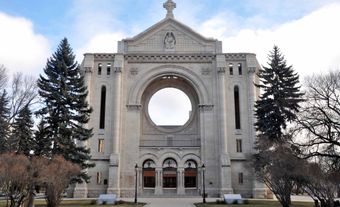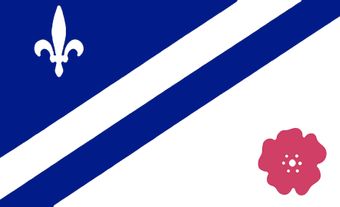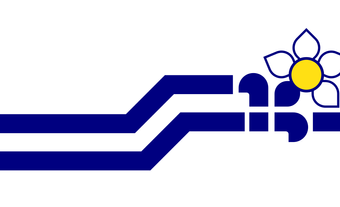Section 23 of the Canadian Charter of Rights and Freedoms ensures the right to instruction in French or English to the children of the francophone and anglophone minority communities in all of Canada’s provinces. Section 23 allows francophones to establish French-language school boards in each of the majority-anglophone provinces. Thanks to this key provision of the Charter, francophones outside of Quebec and anglophones in Quebec can pursue their education in their own language.

(Photo by SimonP/wikimedia)
Origins of Section 23
When the Liberal Party of Canada, under Pierre Elliot Trudeau, returned to power in February 1980, the government redoubled its efforts to patriate the Canadian Constitution from the United Kingdom and to incorporate a charter of rights and freedoms into it. With regard to freedoms, there were several proposals similar to the provisions of the 1960 Canadian Bill of Rights, but the charter also included several new language provisions. On 5 November 1981, the federal government and nine of the provinces agreed on an amending formula to patriate the Constitution, but Quebec was dissatisfied with the conditions of the agreement and did not sign it.
Sections 16 to 20 of the Canadian Charter of Rights and Freedoms, which came into force in April 1982, recognize English and French as the official languages of Canada and the right of citizens and public servants to use these languages in federal institutions. (See also Bilingualism; Official Languages Act.)
Section 23 concerns the right to instruction in the language of the anglophone or francophone minority and comprises three important characteristics:
-
“Citizens of Canada (a) whose first language learned and still understood is that of the English or French linguistic minority population of the province in which they reside, or (b) who have received their primary school instruction” in their mother tongue “have the right to have their children receive primary and secondary school instruction in that language […] out of public funds.”
Did you know?
Francophones outside of Quebec can meet either one of these requirements to obtain access to instruction in French, but for anglophones in Quebec, having English as their mother tongue does not suffice. As a concession made to avoid a conflict with the Charte de la langue française, for their children to have access to instruction in English in Quebec, these anglophones must have received primary school instruction in English in Canada or have a child who has received or is receiving primary school or secondary school instruction in English in Canada.
- The “number of children of citizens who have such a right” must, however, be “sufficient to warrant the provision […] of minority language instruction.”
- This right to instruction “includes, where the number of those children so warrants, the right to have them receive that instruction in minority language educational facilities provided out of public funds.”
While section 23 recognizes the right to instruction in the minority language, it does not recognize the right to establish school boards managed by linguistic minorities. During the negotiations, Franco-Ontarian Member of Parliament Jean-Robert Gauthier did succeed in having the French version of paragraph (3) b) amended so as to replace the phrase installations d’enseignement de la minorité linguistique (minority language educational facilities) with the phrase établissements d’enseignement de la minorité linguistique (minority language educational institutions). This change was intended to imply a greater sense of belonging to the community and thus, it was hoped, force the courts to establish minority-language school boards.
While the Charter affirmed the rights of individuals, it also recognized the rights of official language communities living in minority situations within a bilingual, multicultural federation. Quebec and New Brunswick already met their commitments with regard to their respective linguistic minorities.
Issues of Thresholds and Management
The ambiguities in section 23 and the disadvantaged status of Canada’s French-language school systems drove some language demands into the courts. As early as 1982, groups of francophone parents, trustees and associations were consulting constitutional experts. With the help of the Court Challenges Program (established in 1978), they hired lawyers to pursue two objectives. The first was to clarify the minimum threshold numbers of students, which would make it possible to invalidate discriminatory statutes, regulations and practices concerning the construction of new schools. The second objective was to clarify the meaning of the phrase établissements d’enseignement de la minorité linguistique, which implicitly suggests that minority language educational institutions belong to the community, which therefore manages and controls them to some extent.
In 1983, the government of Ontario was the first to refer section 23 to its province’s Court of Appeal to clarify its obligations. The following year, the Court ruled that the minimum thresholds of 25 students to warrant the establishment of a French-language primary school administration and 20 for a secondary school administration were too high. In the opinion of Court, the institutions had to be seen as an integral part of the social and cultural fabric of the minority, and parents and communities therefore had to be afforded a certain degree of management and control over these institutions.
The provinces had to react to this precedent. In 1985, Ontario formed French-language sections within its bilingual school boards. It made these sections responsible for personnel management, facilities and curriculum. Elected Francophone school board trustees took responsibility for these sections while also managing transportation, budgets and shared spaces together with their anglophone colleagues. Nova Scotia also established Acadian advisory councils within its existing school districts and expanded instruction in French, although science continued to be taught in English. In Newfoundland, the provincial government refused to establish a separate francophone school body, but did open the first French-language school in St. John’s in 1990. (See also Francophones of Newfoundland and Labrador.) Yukon established its first complete school program in French in Whitehorse in 1984, and the Northwest Territories did likewise at Yellowknife in 1989. (See also Francophones of Yukon; Francophones of the Northwest Territories).
In Alberta, bilingual schools and classrooms were open to all and taught up to 80% of their subjects in French. In 1984, the Catholic school board in Edmonton incorporated the Georges and Julia Bugnet private school into its system, but the province refused to subsidize it. The parents therefore used the Court Challenges Program to demonstrate the incompatibility of the Alberta School Act with section 23 of the Charter. The Court of Queen’s Bench of Alberta found that the Charter did confer a degree of management by the communities, but did not require the creation of French-language school boards. The parents took their case to the Court of Appeal, which added that the number of students entitled to instruction in French in Edmonton seemed sufficient to warrant the existence of a francophone school. But the Court refused to invalidate the School Act regulations, because it did not see any conflict with section 23 of the Charter.
In response to this confusion, the Supreme Court of Canada agreed to hear the Franco-Albertan parents’ case. In the Court’s 1990 judgment in Mahe v. Alberta, Justice Brian Dickson wrote that section 23 has a “remedial nature”. The Charter mentions “minority language educational facilities,” which means that these schools belong to the minority and that this minority should therefore have a “degree of management and control.” Justice Dickson pointed to the “inaction of the public authorities” as a “bar to the realization of the appellants’ rights.” As regards the requirement that a minimum of 20 per cent of class time in Alberta be spent on English-language education, not only did it contravene section 23, but Alberta had not even taken the trouble to show why the province persisted in maintaining it. According to the Court, the number of students entitled to French-language instruction in the Edmonton area alone met the higher threshold at which francophone parents would have to be granted a degree of management and control. The province was given eight years to amend its School Act.
Although the judgment in Mahe v. Alberta clarified the spirit of section 23, it did not make the degree of management and control of these schools explicit. In a parallel dispute in 1990, the Manitoba Court of Appeal found that it was up to the province to define the degree of management and control enjoyed by Franco-Manitobans, whereas the Mahe v. Alberta judgment, rendered one month later, affirmed that the “sliding scale” approach should be used to determine it. Given this situation, the Supreme Court agreed to hear an appeal by the Franco-Manitobans in 1993. In Reference re Public Schools Act (Man.), Justice Antonio Lamer pointed out that Mahe v. Alberta had established that a francophone school board in Edmonton would be plausible. Consequently, the number of Franco-Manitoban students (3,000) was more than high enough to warrant “the establishment of an independent French language school board in Manitoba under the exclusive management and control of the French language minority.” The Court ordered that Manitoba must “without delay, put into place both a regime and a system which permit the Francophone minority to exercise its rights effectively.”
In 1993, using start-up funding that was available to all provinces and territories, Manitoba founded the Franco-manitoban School Division. In 1994, Alberta followed suit, establishing three regional school boards. In 1995, Saskatchewan created seven small francophone school divisions; four years later, it merged them into a single Fransaskois school division. (See also Francophones of Saskatchewan.) In British Columbia, francophone parents had to wait until 1996 for the province’s Supreme Court to order its government to establish a provincial francophone school board. The province did so in the following year, but the amount of funding granted was enough for this board to serve only 15% of the 19,000 students in the province who were entitled to instruction in French. (See also Francophones of British Columbia.)
In Ontario, religious rights complicated the creation of francophone school boards. Nevertheless, the province established the Metropolitan Toronto and Ottawa-Carleton French-language public school boards in 1988 and the Prescott-Russell French-language Catholic separate school board in 1992. In 1998, a provincial reform merged the 3 French-language boards, 8 francophone committees, 59 French advisory councils and 90,000 francophone students into 12 French-language boards (4 public and 8 Catholic).
Francophone school boards were also established, with federal funding, in Newfoundland (1997), the Northwest Territories (1997) and Nunavut (2001).
Issues of Power, Equality and Access
On Prince Edward Island, Unit 5 has managed French-language education throughout the province since 1988. In 1994, Unit 5 announced construction of a school in Summerside, but the Minister of Education cancelled the decision, on the pretext that there was already a school in Abram-Village, 27 kilometres to the west. The PEI Court of Appeal did not see busing students this distance as a bar to an education of equal quality, but the Supreme Court agreed to hear an appeal on the discretionary powers of a minister. In 2000, it ruled that it was up to Unit 5 to decide what was most appropriate in light of its constitutional obligations.
In Nova Scotia, in 1996, the provincial government established the Conseil scolaire acadien provincial (provincial Acadian school board) to manage Acadian schools, but left the decision whether to build a French-language school up to the Minister. In 1999, plans to build five secondary schools were cancelled, leading Acadian parents to file an appeal. Justice Arthur LeBlanc of the Nova Scotia Supreme Court invalidated the province’s decision, arguing the urgent need to take action to counter the disturbing rate of assimilation among young Acadians. Although the province contested the judge’s requirement to submit reports on the progress achieved, the Supreme Court found in his favour in 2002. Indeed, the Charter does allow judges to be creative in ordering remedial measures to address infringements of rights, so that parents need not constantly turn to the courts for redress. (See also Acadia; Acadian French.)
As regards the quality of school facilities, francophone parents in British Columbia went to court over the condition of the Rose-des-Vents elementary school in Vancouver. This school was operating at 72% above its rated capacity, had no windows at several places, and had numerous sanitation problems. The tiny, crowded classrooms had contributed to an outbreak of head lice among the students. In addition, most of the students had to be bused long distances to get to the school. The contrast with English-language schools in the area was indisputable. In 2015, the Supreme Court found that the building did not satisfy the standard of real equality. In the following year, the provincial Supreme Court ruled that the province had to put things right; this decision was confirmed by the Supreme Court in 2020.
In Yukon, the question of eligibility to attend school in French arose. Since its founding in 1996, the territory’s francophone school board had been admitting students to the Émilie Tremblay elementary school freely. But in 2009, the territory ordered the board to admit only “rights holders” from then on. (Manitoba and Ontario had authorized school admission committees to expand their criteria beyond rights-holders in 1987 and 1990, respectively, but Yukon had never officially delegated that responsibility to the board.) The Supreme Court recognized that “the Yukon’s approach to admissions prevents the realization of s. 23’s purpose.” In 2016, the parties reached an agreement, and the school board was authorized to decide for itself whether to admit non-rights-holders, but was also required to report to the territorial government yearly on the number of students whose parents did not meet the section 23 criteria. This group included children of francophone immigrants, children whose grandparents’ mother tongue was French, and francophile students.
Impact of Section 23
Some 10 landmark decisions by the Supreme Court transformed the Canadian school landscape over the years 1960 to 2000. All major Canadian cities now offer a French-language education from kindergarten through Grade 12, and the education ministries of all the provinces now have hundreds of specialists and thousands of teachers who deliver this education.
These 630 francophone schools outside of Quebec are attended by 160,000 students, a good number of whom become active francophones. The disputes nowadays are about revising funding formulas, modernizing buildings and updating the concept of rights-holders. As Pierre Foucher puts it, “Without section 23, none of this would have happened.”

 Share on Facebook
Share on Facebook Share on X
Share on X Share by Email
Share by Email Share on Google Classroom
Share on Google Classroom











